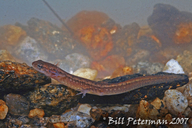|
Eurycea wilderae Dunn, 1920
Blue Ridge Two-lined Salamander Subgenus: Manculus | family: Plethodontidae subfamily: Hemidactyliinae genus: Eurycea |
 © 2007 Bill Peterman (1 of 47) |
|
|
|
Distribution and Habitat Country distribution from AmphibiaWeb's database: United States U.S. state distribution from AmphibiaWeb's database: Georgia, North Carolina, Tennessee, Virginia
Comments Despite lacking specialized climbing structures, a wide range of salamanders are known to climb vegetation, trees, or rocks. Their ability to cling and climb allows these salamanders access to more food resources, to more suitable microclimates, and to escape predators. O'Donnell and Deban (2021) explored what factors contribute to this ability across a wide range of size, morphology, and ecological niches in salamanders. They found that the adhesive nature of their mucus coating was a major factor, but that cling ability also was associated with body mass and the amount of body contact area utilized, which include feet, tail, belly, and ventral surface of their head, to increase cling. The best clingers in their experiments were the small plethodontid salamanders, such as Batrachoseps attenuatus, Desmognathus aeneus, D. ocoee, Eurycea guttolineata, and E. wilderae. However, plethodontid salamanders in general, like large salamander Desmognathus quadramaculatus, were comparable or exceed the cling ability of arboreal and scansorial frogs. (AChang)Watch Eurycea wilderae use its projectile tongue in slow motion: Edited by: Michelle S. Koo (2021-08-29) Species Account Citation: AmphibiaWeb 2021 Eurycea wilderae: Blue Ridge Two-lined Salamander <https://amphibiaweb.org/species/4061> University of California, Berkeley, CA, USA. Accessed Nov 25, 2024.
Feedback or comments about this page.
Citation: AmphibiaWeb. 2024. <https://amphibiaweb.org> University of California, Berkeley, CA, USA. Accessed 25 Nov 2024. AmphibiaWeb's policy on data use. |




 Raffaëlli Account
Raffaëlli Account Map of Life
Map of Life